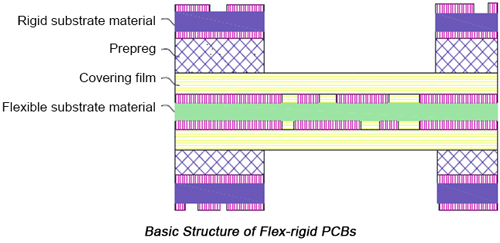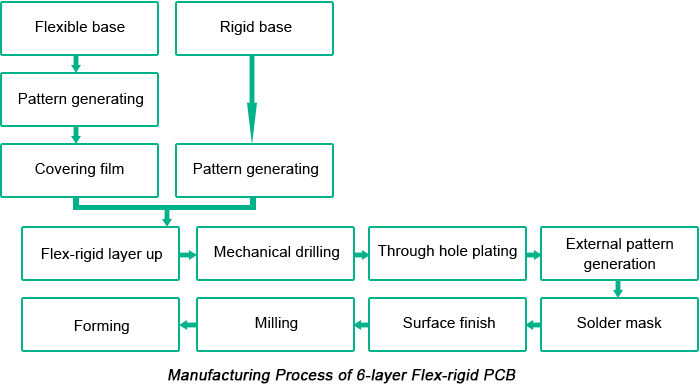Everything You Should Know about Flex-Rigid PCB Manufacturing Technology
Due to development trend of aerospace products including light weight, miniaturization, multifunction and assembly densification, higher requirement has been WHERE set up for Printed Circuit Board (PCB) technology and manufacturing process. Flexible PCBs are a type of circuit boards that are made of flexible substrate material and feature more advantages than ordinarily rigid PCBs:
Lower thickness
Lighter weight
Dynamically bendable
Accessible for 3D interconnection assembly
Higher freedom on electronic design and mechanical design
More space saving
Furthermore, electromagnetic signals can run quickly and smoothly in flex PCBs owing to excellent electrical performance and thermal performance of flexible substrate material so that flexible PCBs are widely applied in many industries like instrument, automotives, medical care, military and aerospace.
Based on the further development and optimization of flexible PCBs, the next step for them should be Flex-Rigid PCBs, Embedded Flexible Circuits and HDI Flex PCBs among which Flex-Rigid PCBs attract the most attention and applications. Therefore, this article will discuss properties and application fields of Flex-rigid PCBs based on their material and manufacturing technologies.
Material of Flex-Rigid PCBs
The performance of flex-rigid PCBs depends on that of substrate material of them that primarily contains flexible dielectric film and flexible adhesive film. As a leading type of flexible substrate material, flexible dielectric film mainly includes polyester (Mylar) that is usually used in low-end products, polyimide (Kapton) that is the commonest type, and fluoropolymer (PTFE) that is usually used in military and aerospace products.
As those three types of flexible materials are compared, polyimide features the highest dielectric constant with excellent electrical and mechanical properties and high-temperature resistance but is expensive and easy to absorb moisture. Similar with polyimide in terms of performance, polyester, however, features bad high-temperature resistance. Polytetrafluoroethylene is primarily used in high-frequency products with low dielectric constant. The following table demonstrates performance comparison between the above three types of flexible dielectric film.
Performance Item | Polyester | Polyimide | Polytetrafluoroethylene |
Limit Tension/N*mm-2 | 172 | 172 | 20.7 |
Limit Elongation/% | 120 | 70 | 300 |
Size Change After Etching/mm*m-1 | 5.0 | 2.5 | 5.0 |
Relative Dielectric Constant/103Hz | 3.2 | 3.5 | 22.1 |
Loss Angle Tangent/103Hz | 0.005 | 0.0025 | 0.0001 |
Volume Resistance/MΩ*cm-1 | 1012 | 1012 | 1012 |
Flammability | Flammable | Self-extinguishing | Inflammable |
Dielectric Strength/mV*m | 300 | 275 | 17 |
Moisture Absorption/% | <0.8 | 2.7 | 0.01 |
Heat Resistance/°C | 150 | 400 | 260 |
Soldering Test | Pass | Pass | Pass |
The leading material contributing to flexible adhesive film contains acrylic acid, epoxy and polyester. Acrylic acid and polyesterimide feature excellent adhesion, high flexibility and relatively high chemical resistance and heat resistance. However, it features a relatively large coefficient of thermal expansion so its internal thickness should not be over 0.05mm. Epoxy resin features bad adhesion and is mainly applied to stick covering layer and internal layer. Moreover, it features such a low coefficient of thermal expansion that it's beneficial to thermal shock resistance improvement of plated through holes.
Manufacturing Technology of Flex-Rigid PCBs
Manufacturing technologies of flex-rigid PCBs differ from each other in accordance with different types of PCB boards and the essential technology leading to the differences is fine circuit manufacturing technology and microvia manufacturing technology. As electronic products tend to develop towards light weight and miniaturization, multifunction and assembly densification, advanced PCB boards attracting the most attention include HDI flex-rigid PCBs and embedded flex-rigid PCBs.
Flex-Rigid PCB Manufacturing Technology
Flex-rigid PCBs are fabricated through orderly and selective layer stackup of rigid and flexible PCBs with plated through holes responsible for connection between layers. Below figure indicates the basic structure of flex-rigid PCB.

Advent of flex-rigid PCBs can effectively reduce electronic product's volume and quality by replacing harness and connectors that were usually applied in electronic products. Furthermore, flex-rigid PCBs are capable of solving contact and intense heat problems caused by harness and connectors, drastically improving reliability of devices.
As early as 1970s, flex-rigid PCBs were manufactured by stacking up rigid board onto flexible board. Consistent progress and optimization have witnessed numerous new types of flex-rigid PCB manufacturing technologies. Up to now, the most mature and practical flex-rigid PCB manufacturing technology is that glass fiber epoxy resin (FR4) is applied as external rigid board and solder mask is applied to protect rigid circuit pattern. When it comes to flexible substrate material, polyimide (PI) double-layer board covered with copper is applied as a flexible core and polyimide/acrylic film is used to protect flexible circuit pattern. Adhesion depends on Low-flow prepreg. All those elements are laminated so that flex-rigid PCBs are manufactured. The figure below demonstrates the manufacturing process of a 6-layer flex-rigid PCB.

Flex-rigid PCBs can defeat problems of loose contact and thermal dissipation by taking place of harness and connectors so that device reliability can be improved. Flexible part can be freely bent at any angle and the whole PCB board performs excellently in terms of electrical performance and mechanical properties. Thus, flex-rigid PCBs is accessible for 3D assembly and product's freedom degree can be increased with equipment volume and quality reduced so that they are well applied in electronic devices that need to be bent over and over again. Flexible substrate material features such excellent dielectric stability that they are fit for high-frequency signal transmission and impedance control and can withstand radiation, temperature shock and extreme environment, ensuring smooth running of electronic devices.
Traditional flex-rigid PCBs are hard to be manufactured with a relatively low yield rate and high density and difficult to be repaired after breakdown. During PCB manufacturing process, rigid base needs to be embedded into expensive flexible substrate material so that raw material waste rate remains high and so does manufacturing technology difficulty. Flexible substrate material features such a relatively high coefficient of thermal expansion and high moisture absorption rate that large-area flexible substrate material will lead to size tolerance accumulation, which will further affect circuit pattern, layer up, drilling, plating and via cleaning and lead to low yield. Embedded flexible circuits, however, are capable of effectively reducing and avoiding such issues.
Embedded Flexible PCB Manufacturing Technology
Embedded flexible PCBs are printed by embedding flexible circuit units into internal rigid boards, then go through Building Up Process. Interconnections are not available between flexible circuit and rigid circuit in the equivalent layer and their connection depends on blind vias and buried vias. Embedded flex-rigid PCBs can get flexible circuits dramatically reduced and they contain advantages of HDI and rigid PCBs with substrate material waste rate reduced.
Compared with traditional flex-rigid PCBs, embedded flex PCBs are manufactured by embedding flexible circuit into rigid board and then layering up. Flexible area is larger that of flexible circuit unit, increasing flexible substrate material usage rate improved. Since no electrical connection is available between flexible circuit and rigid circuit in the same layer, some advanced manufacturing technologies can be easily obtained through the connection between plating through holes and rigid circuit.
To some extent, embedded flex PCBs get to solve lots of problems in flex-rigid PCB manufacturing technology. Embedded unit drastically cut down substrate material waste rate and effectively increase flexible substrate usage rate. Flexible substrate material performance issues can be neglected and mature manufacturing technologies of rigid boards can be directly applied so that HDI technology can be further developed in flex-rigid PCB manufacturing.
Capabilities
Payment Methods
Specials Price
Carriers
Support Hobbyist
Certificate
Customer Support
Follow Us
Tel: 1-905-339-2881
Email: [email protected] , [email protected]
Copyright Gold Phoenix PCB Co., Ltd. 2011 - 2023
Tel: 1-905-339-2881 Email: [email protected] , [email protected]
Quality Control System
|
Products/Service
|
Friendly Links
Copyright Gold Phoenix PCB Co., Ltd. 2011 - 2023


